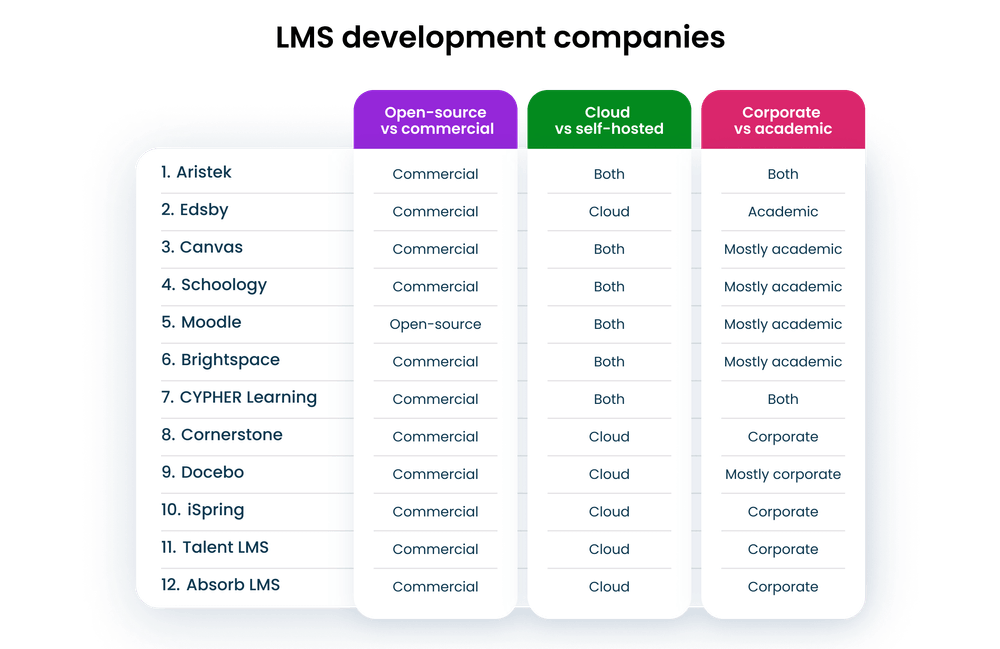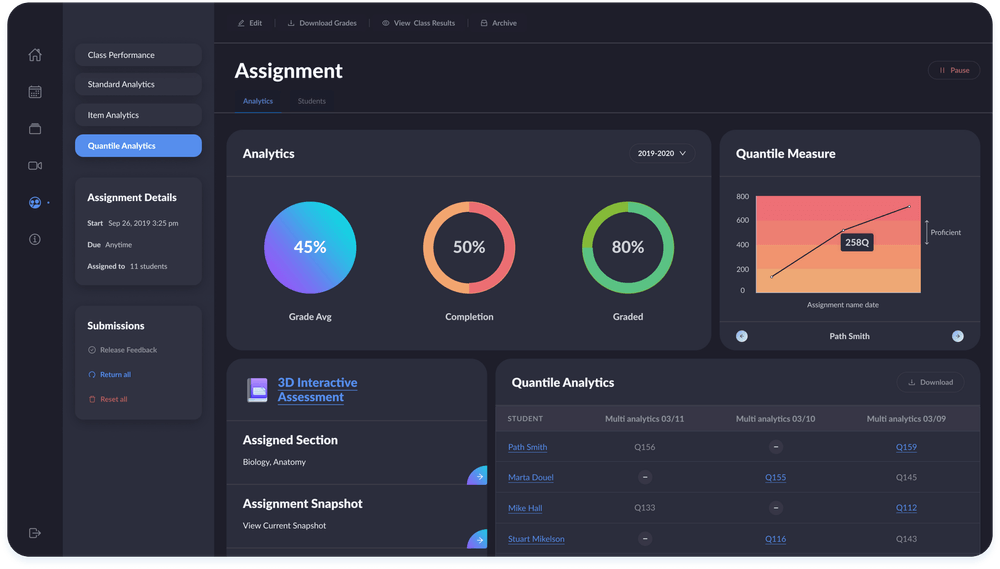Let’s go back to the basics for a minute. Simply put, an LMS is software that allows one to create, manage, organize, and deliver online training materials. With an LMS, it’s easier to keep students’ knowledge up to date, whether it is in a company or an educational organization.
The global online learning market, which includes LMS end users from academic, corporate, government, and other sectors, is expected to grow by 12.8% by 2030. However, despite this significant growth, many companies struggle with choosing the right LMS.
No wonder: after all, there is a large selection of different solutions that all meet different requirements.
In this material, we have compiled different LMS so that you can get an initial overview of solutions that will be popular in the upcoming 2025 and make a preliminary choice for yourself.
What types of LMS exist?
Open-source vs commercial. Open-source means that the LMS is free, anyone can download or contribute to them. Note, that with open source you’ll need to host your LMS by yourself. There’s no tech support either, you’ll be on your own. Unless you hire a 3rd party company that’ll maintain the software for you.
Commercial software is the old school distribution model. A LMS development company makes an LMS and sells it to the customer. It’s more expensive but includes perks like technical support and cloud hosting.
Cloud vs self-hosted. Cloud LMS are hosted on the servers of the developer, while self-hosted LMS don’t provide hosting. If you choose a self-hosted LMS, you’ll need to either set up private servers or go to an LMS hosting company that will take care of it.
Corporate vs academic. Academic LMS are tailored for class schedules, grading, and academic content. Corporate LMS are suited for employee onboarding, skill tracking, and compliance training. These features are often similar, so LMS development companies often serve both academic and corporate clients simultaneously.
Simple vs advanced analytics. Some LMS only track grades and studying time, while others use AI and xAPI for advanced analytics. It’s a huge topic, and we have a separate article on LMS analytics. Feel free to read it.
What are the best LMS development companies?
Before we dive into the sheet, we need to understand what was worth looking at when choosing an LMS in 2024 (you can lean on them in early 2025, and if you want personalized advice, contact us directly).
Here are three key takeaways from the Forrester’s expert view:
- Most learning platforms now include native authoring tools, making separate purchases of standalone authoring tools like Adobe Captivate unnecessary. Organizations should reassess their learning platform’s capabilities before investing in additional tools.
- Traditional distinctions between LMS, LXP, DAP, and skills development platforms are fading as learning platforms increasingly integrate multiple functionalities. As a result, organizations might need fewer platforms than before to meet their learning needs.
- While generative AI (genAI) offers exciting new features for creating interactive learning experiences, it also presents risks such as potential copyright violations and errors. It’s important to understand GenAI’s mechanisms and evaluate the associated risks before implementing it.
Here’s a list of popular LMS platforms that reflect these key insights. Each of these platforms serves different audiences, but they all exemplify the trends and considerations highlighted for choosing an LMS in 2025.

1. Aristek
Aristek’s pre-built LMS is a perfect one for content publishers. While major LMS are great for schools and universities, they do not integrate very well. So if a content provider gets an LMS, they struggle to sell content to customers with another software. With Aristek, publishers can sell curricula to districts, regardless of their LMS.
Tailors to meet specific organizational goals, with the ability to add any AI-powered custom features and integrations.
Key features:
- Offers the option to store data on private servers or in the cloud.
- Lifetime ownership with no license fees, saving long-term costs compared to SaaS.
- Pre-built modules for core functionality and rapid setup within 1+ month
- Custom integrations with SCORM, APIs, and advanced branding options
2. Edsby
Edsby is a social learning platform designed for K-12 education, focused on fostering communication and connections among students, teachers, and families. It supports in-class, hybrid, and online learning. Widely used in school districts and some entire regions, Edsby can be augmented with tailored 3rd party tools to meet the specific needs of K-6 and 7-12 students.
Key features:
- Social-style interface designed for ease of use in K-12 environments.
- Comprehensive tools for learning management, student assessment, and well-being tracking.
- Scalable for use by individual districts or entire countries.
3. Canvas
Canvas LMS is a cloud-based learning management system known for its user-friendly interface, designed to simplify course management and communication for universities and schools. With over 200 LTI tools, it allows for seamless integration with existing school systems and easy management of courses, content, and student interaction.
Key features:
- Supports blended learning, offering native mobile apps for iOS and Android devices.
- Tracks academic performance and learning progress with data-driven insights.
4. Schoology
Schoology is a virtual learning environment and social networking platform designed for universities and higher education institutions. It enables users to create, manage, and share academic content. However, users note that the process of grading assignments is cumbersome, missing some key third-party integration options.
Key features:
- Allows for easy creation and distribution of teaching materials, as well as integration with various e-learning services.
- Offers live group events, webinars, and personalized lessons.
5. Moodle
Moodle is an open-source LMS. In part thanks to the free options, Moodle is popular globally and is used for K-12, higher education, vocational training, corporates, and enterprise learning. With over 2000 open-source plugins, Moodle is easily customizable. It used to have the reputation of an old-school LMS, but Moodle 4 is a modern and sleek platform.
Key features:
- Seamless integration with other platforms for various educational and corporate training environments.
- Access to 24/7 expert support through Moodle Certified Partners and Service Providers.
6. D2L Brightspace
D2L’s Brightspace is a cloud-based learning management system designed to provide personalized and meaningful learning experiences, supporting over 18 million learners worldwide. Like some other LMS, Brightspace has great analytic tools that empower instructors to track student progress.
Key features:
- Personalized learning experiences tailored to individual learner needs.
- Innovative tools to enhance engagement and skills development.
- Supports learners of all ages with advanced pedagogical features.
7. CYPHER Learning
NEO is a learning management system designed for schools and universities, helping manage classroom activities such as content delivery, student assessment, and collaboration. Developed by CYPHER LEARNING, NEO is used by a wide range of educational institutions, from large universities to small schools worldwide.
Key features:
- Integration of LMS, LXP, and content development into one platform.
- AI-powered automation for personalized learning, content creation in 50+ languages, and detailed learner tracking.
8. Cornerstone
With over 7000 clients and 125 million users, Cornerstone is trusted by brands like Samsung and DHL. The LMS focuses on personalized development with custom learning paths. It also provides lots of data insights about employee learning productivity.
Key features:
- Comprehensive insights on learning progress, skill gaps, and career advancement.
- Diverse training options including podcasts, videos, articles, and eLearning.
9. Docebo
Docebo is a major corporate LMS with over 3500 clients worldwide, from Coca-Cola to Lego. They are a great choice for companies in need of an onboarding platform, customer education, or sales enablement software. With advanced AI capabilities, the LMS makes content creation faster and more efficient. Meanwhile, some users note that Docebo’s setup and maintenance require technical expertise, posing challenges for smaller institutions.
Key features:
- AI-driven automation streamlines tasks like enrollments and content categorization.
- Custom branding allows for tailored learning experiences.
10. iSpring Learn
iSpring Learn is popular is big on compliance training, as a result, they are popular in automotive and healthcare businesses. With support for various content formats and mobile accessibility, iSpring handles onboarding, skill training, and microlearning. It’s a great LMS for employee certification, in addition, it allows for branding customization.
Key features:
- Users can upload various file formats such as DOC, XLS, PDF, SCORM, FLV, MP4, and Flash clips and organize them into chapters.
- Gamification elements boost learner engagement and improve completion rates.
- Flexible hosting options, including cloud and on-premise.
11. Talent LMS
TalentLMS is utilized across 30+ industries to train employees, partners, and customers. Particularly favored by small to mid-sized companies, notable users include Amazon, Meta, eBay, OpenAI, and Isuzu. This LMS does not operate in the education sector and doesn’t support SCORM.
Key features:
- User-friendly interface that allows for a smooth training experience across devices.
- Extensive customization options to tailor training content to specific teams.
- Integration of TalentLibrary, a growing collection of ready-made courses.
12. Absorb LMS
Absorb is a corporate LMS company great for compliance, onboarding, and employee development. With a focus on compliance training, the platform offers comprehensive tools to streamline training, track progress, and ensure organizations meet regulatory standards. The LMS automates certificate renewals and reminds employees about the training.
Key features:
- A comprehensive turn-key content library that includes expert-created courses.
- Seamless integration with HCM software for scalable learning programs and simplified administration.
How to integrate LMS with other software?
There are some excellent options for LMS integrations, each with its own benefits and use cases. Depends on what integration type suits your current business needs best.
No-code integrations. Most LMS will have seamless integrations with MS Teams, Zoom, and other popular tools. If you choose wisely, there will be no coding required for such integrations.
Custom integrations via API. Major LMS will typically have API integrations. API is a programming interface that links services with each other. You’ll need to hire developers, and you’ll get to integrate LMS with another software app.

Integrate LMS with another LMS or SIS. You’d do this if you are a curriculum publisher, and your clients have different LMS from yours. Even then, you’ll probably be able to export content via SCORM – but that’s not what school districts expect. They’ll want an LTI integration.
Yet most LMS don’t export content via LTI. To get clients with different LMSs, you’ll need an intermediary tool. If you want to know more, read about LMS content integration.
Customize any LMS to your needs
If you need a custom LMS development company, we’re here to help.
Our LMS is used by millions of people, from students to businesses. Here are just a couple of examples: a major K-12 LMS, an LMS integration tool, and business software for US school districts.

In a nutshell
Every LMS is different, so check which one fits you best. Some are great for corporate training, others are perfect for K-12 education.
Smaller LMS companies develop niche solutions like our customizable LMS for publishers. They fill the market gaps with unique features.
Want to learn more about LMS? Get in touch. We’ll help you find the right LMS specifically for your needs.




